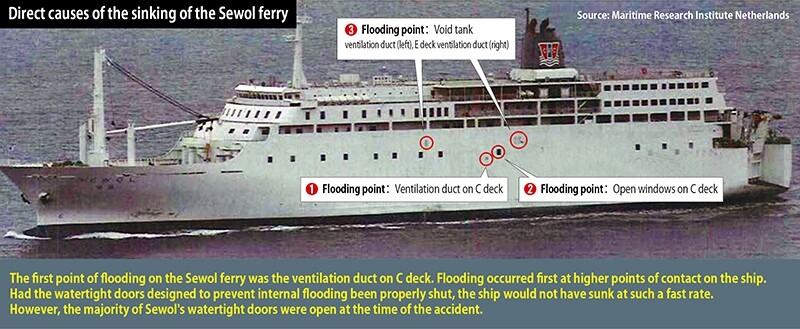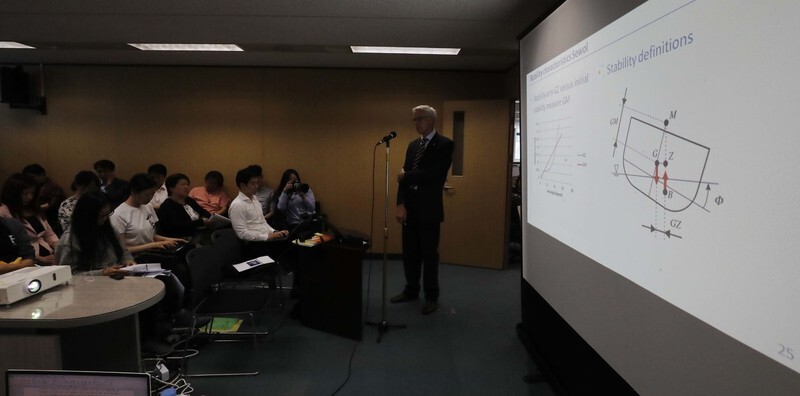hankyoreh
Links to other country sites 다른 나라 사이트 링크
Simple safety protocols would have saved the Sewol, study indicates

If the watertight doors on the Sewol ferry had been shut properly, the ferry would not have sunk so quickly, according to the results of a study by an overseas maritime institute that was published on May 30.
Watertight doors are designed to seal off chambers on the ship to prevent rapid flooding. According to another analysis, the ship would not have sunk if the cargo had been properly secured. In other words, if even one of the protocols and regulations designed to save lives had been obeyed, the tragedy of that day could have been prevented.
On May 30, the Sewol Investigation Commission (SIC) held an event at its office, in the Jeo neighborhood of Seoul, to announce the results of an investigation into the Sewol sinking by MARIN (Maritime Research Institute Netherlands). The SIC had commissioned MARIN to investigate the cause of the sinking.
“If the watertight doors [in the lower section of the Sewol] had been shut, the ferry would not have gone down so rapidly. We estimate that it would have remained floating at a list of 65 degrees for a long time,” a representative from MARIN said during the event.
In the engine room at the bottom of the Sewol there were two watertight doors and five watertight manholes. But SIC investigators recently found that all of them were open at the time of the accident. Furthermore, there were a total of 10 watertight doors and manholes on the D deck, at the bottom of the hull, but only about three of these were presumably closed. Regulations state that watertight doors must be closed in the case of an emergency to prevent the ship from keeling over in the waves.
MARIN’s analysis found that if the 17 watertight doors and manholes in the engine room and on D deck had been closed, the ferry would have been able to stay afloat for a considerable time at a list of 65 degrees. That would basically have created a “golden time” during which the passengers could have been rescued.
This conclusion becomes even more compelling when one looks at MARIN’s experimental findings about how the Sewol was flooded. These experiments show that the first direct flooding of the ferry occurred via the ventilation duct on C deck when the ferry had reached a list of 45 degrees. The seawater that flowed in through this duct passed through the ventilation ducts to the room housing the stabilizer. (The stabilizers are balancing fins on both sides of a ship, in the middle at the bottom of the hull.)
The problem was what happened next. The water that collected in the stabilizer room flowed directly into the engine room. If the watertight doors in the engine room had been closed, the ship would presumably not have flooded so abruptly. The second instance of direct flooding occurred when the ship reached a list of 48 degrees and water poured through the windows that were open on C deck.

Properly securing cargo would have prevented tilting more than 33 degrees
The second cause of the ferry’s sinking was poor load securing. The results of investigations by the SIC and MARIN show that the Sewol started to tilt when it made a sudden turn to the right at 8:49 am on Apr. 16, 2014. The Sewol’s cargo began to move when the hull reached a list of 18 degrees, with some of the cargo sliding at that point. When the hull reached a list of 33 degrees, nearly all the cargo slid down, because it had not been properly fastened. Just 56 seconds after the ship had made its sharp turn, the ferry had reached a list of 45 degrees and began to take on water.
“If the cargo had been properly tied down, the ship would not have listed beyond 33 degrees,” MARIN’s chief investigator told The Hankyoreh. The load securing was also linked to the ferry taking on water. After all, if the ferry had not tilted more than 33 degrees when the cargo shifted, then it would not have reached a list of 45 degrees, when the first instance of flooding occurred. But the poor cargo securing ultimately played a major role in causing the ship to keep tilting to the right.
“I think the cargo securing was another important factor that caused the sinking,” the MARIN representative said on May 30.
At the SIC’s request, MARIN carried out a computer simulation, a free running model test and a flood model test. The free running model test recreated the conditions at the time of the tragedy, including the Sewol’s wake, by placing a 1:25 model of the ferry into a large tank of water. The flood model test used a 1:30 model of the Sewol to recreate how it sank after reaching a list of 45 degrees.
MARIN’s experimental results that were announced on May 30 do not represent the SIC’s final conclusion about the cause of the Sewol’s sinking. But the SIC plans to treat MARIN’s findings as an important reference material. After concluding its investigation into other suggested causes – including engine failure and the possibility that force was exerted from the outside – the SIC will reach its final conclusion about the sinking of the Sewol.
By Jung Hwan-bong, staff reporter
Please direct comments or questions to [english@hani.co.kr]

Editorial・opinion
![[Guest essay] Amending the Constitution is Yoon’s key to leaving office in public’s good graces [Guest essay] Amending the Constitution is Yoon’s key to leaving office in public’s good graces](https://flexible.img.hani.co.kr/flexible/normal/500/300/imgdb/original/2024/0416/8917132552387962.jpg) [Guest essay] Amending the Constitution is Yoon’s key to leaving office in public’s good graces
[Guest essay] Amending the Constitution is Yoon’s key to leaving office in public’s good graces![[Editorial] 10 years on, lessons of Sewol tragedy must never be forgotten [Editorial] 10 years on, lessons of Sewol tragedy must never be forgotten](https://flexible.img.hani.co.kr/flexible/normal/500/300/imgdb/original/2024/0416/8317132536568958.jpg) [Editorial] 10 years on, lessons of Sewol tragedy must never be forgotten
[Editorial] 10 years on, lessons of Sewol tragedy must never be forgotten- [Column] A death blow to Korea’s prosecutor politics
- [Correspondent’s column] The US and the end of Japanese pacifism
- [Guest essay] How Korea turned its trainee doctors into monsters
- [Guest essay] As someone who helped forge Seoul-Moscow ties, their status today troubles me
- [Editorial] Koreans sent a loud and clear message to Yoon
- [Column] In Korea’s midterm elections, it’s time for accountability
- [Guest essay] At only 26, I’ve seen 4 wars in my home of Gaza
- [Column] Syngman Rhee’s bloody legacy in Jeju
Most viewed articles
- 1[Guest essay] How Korea turned its trainee doctors into monsters
- 2[Column] A death blow to Korea’s prosecutor politics
- 3[News analysis] Watershed augmentation of US-Japan alliance to put Korea’s diplomacy to the test
- 4‘National emergency’: Why Korean voters handed 192 seats to opposition parties
- 5[Photo] Cho Kuk and company march on prosecutors’ office for probe into first lady
- 6Exchange rate, oil prices, inflation: Can Korea overcome an economic triple whammy?
- 7After Iran’s attack, can the US stop Israel from starting a regional war?
- 8US grants Samsung up to $6.4B in subsidies for its chip investments there
- 9[Guest essay] Amending the Constitution is Yoon’s key to leaving office in public’s good graces
- 10Student made first call for rescue from sinking Sewol ferry